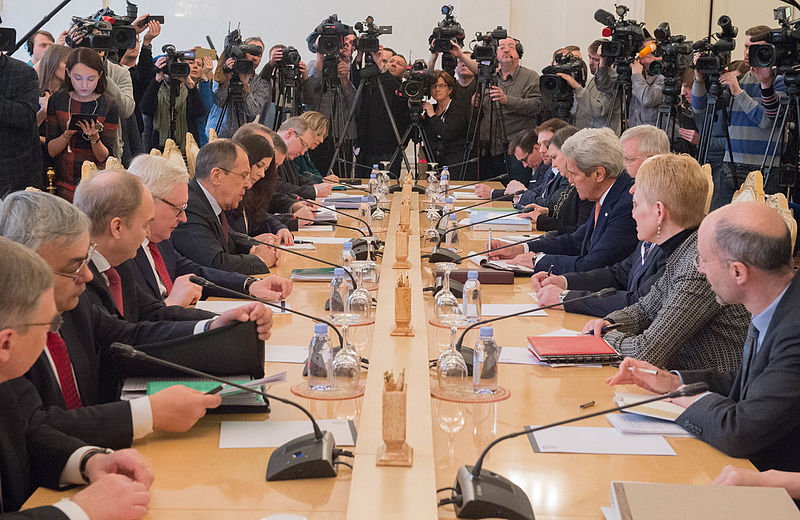A Modern Day Cold War
BY BEN MARCHMAN 
On Apr. 12, two Russian SU-24 jets strafed the USS Donald Cook as it was navigating the Baltic Sea. Video released that Wednesday by the U.S. European Command shows the crew of the Donald Cook observing the two jets make multiple strafing runs in a “simulated attack pattern”. The United States alleges that these strafing runs were dangerous and could have resulted in a serious accident. U.S. Secretary of State John Kerry went a step further and warned that the United States could have shot down the Russian jets according to rules of engagement. The encounter seems like a scene straight out of Top Gun or another classic movie of the Cold War period. However, while the year is 2016 and the Cold War is supposedly over, these incidents are becoming increasingly common, as Russia is once again aggressively asserting its military power on a global scale in Syria, Ukraine, and against NATO. Is the United States doomed to a ratcheting up of hostility and more incidents such as these? Is the second Cold War upon us? If the growing budget for U.S. European Command and NATO posturing are any indication, it may very well be.
Since the Russian annexation of Crimea, NATO has taken a hard stance against Russia even going so far as to suspend military talks between the two. This obvious violation of international law on the part of Russia has caused a hardened rhetoric from the U.S. and NATO. Both powers indicate that Russia is a destabilizing force for European security. Even the Polish Foreign Minister Witold Waszczykowski has said that Russia poses a far greater existential threat than the so-called Islamic State. In response, the United States has promised to allocate more money for the U.S. European Command which is largely seen as a direct reaction to Russian assertiveness on the global stage. The rhetoric and the close calls we saw on April 12th will continue as long as Russia antagonizes the United States and European security. In Russia’s grand strategy it is important to show that their military strength has returned and will pose a challenge to American dominance in global affairs. In Syria, Russia allied itself with the despotic President Bashar al-Assad and began concentrated air strikes supposedly targeting the Islamic State. In reality, it seems they targeted U.S.-backed rebel groups, the Islamic State, and civilian targets alike all to prop up the Assad regime. In a larger sense Ukraine, Syria, and the multiple encounters between NATO and Russian forces are part of the same geopolitical goal; showing that the Russian military is still engaged in global security, challenge American dominance, and pushing back NATO’s growing strength in Eastern Europe. This last point proves the most important in any discussion of April’s encounter.
NATO is not without fault in this whole matter. After Russia annexed Crimea, NATO ended the bilateral NATO-Russia council in March 2014. NATO has also increasingly ramped up its rhetoric and has directly accused Russia of destabilizing European peace and security. No one disagrees that Russia annexed Crimea and has been making more and more aggressive moves, but as Jeffrey Tayler of Foreign Policy Magazine points out it is largely dependent on whether you see Russia’s actions as reactive or proactive. Tayler argues that Russia is largely reacting to NATO expansion into Eastern Europe and thus NATO and the United States should take a less hostile tone and slow or stop expansion into Eastern Europe. It is not a stretch to say that the U.S. and NATO have stoked the fires of Russian aggression, but it is a stretch to take the blame off of Russia. At the end of the day, placing NATO and U.S. actions in the context of Russian aggression should be explanatory, but not as a means to vindicate Russian action.
Now is all this aggression and rhetoric the start of a modern-day Cold War? It might be, as long as both sides do not tone down their rhetoric and as long as Russia makes increasingly bellicose threats. Thankfully these incidents seem to have spurred a renewed sense of urgency in addressing problems between NATO and Russia. Both sides seem to agree that without communication, a serious accident could occur which would significantly raise the possibility of a military encounter between the United States and Russia. The United States should, of course, understand how NATO’s expansion into Eastern Europe impacts Russian military posturing, but it is also necessary for Russia to cease its overly aggressive actions in places like Crimea, Syria, and in individual encounters. This close flyby and others that are likely to come will decide whether NATO, Russia, and the United States will continue to aggressively push their military positions or will start a renewed and hopefully productive dialogue.